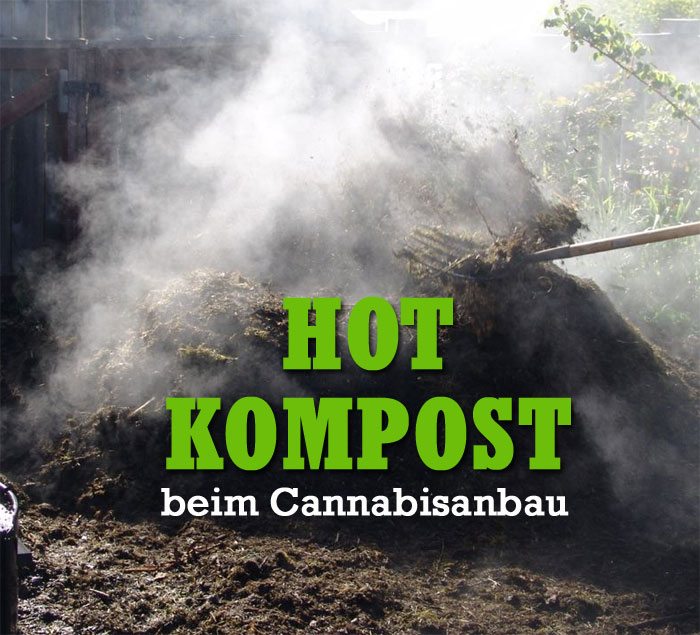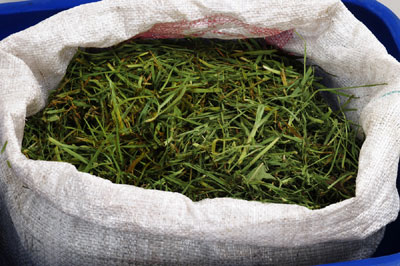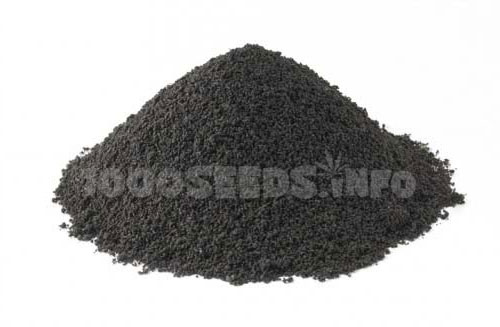Hot composting: a helpful method for cannabis cultivation

Regular composting is also called cold composting. In this process, numerous organic materials are placed in a ready-made compost, a grid housing or just in a pile. Then you wait until the plant materials have decomposed and broken down. This process takes several months, usually 6-12 months. By turning, mixing and turning the compost often, it gets more oxygen and the composting time can be shortened. Nevertheless, the waiting time is relatively long.
Hot composting produces compost in a shorter time. In addition, this method has the great advantage that pathogens, parasites and harmful fungi are killed. The plant material is broken down into fine compost. In addition, the resulting heat destroys weed seeds and you have fewer problems later on. Weed seeds in your homemade cannabis soil can become a nuisance, weeds take up precious space and hinder the cannabis plants from growing. Cold composting, on the other hand, keeps all weed seeds active.
Within a "cold" compost, pathogens are not destroyed. If diseased plants or parts of them end up in the compost, they can later transmit diseases to other plants.
Below we introduce you to a high temperature composting technique that can produce high quality compost in a short time. It takes about 20 days.
This must be taken into account during hot composting:
- The temperature of the compost is kept at 55-65° C
- The carbon : nitrogen ratio of the compost material should be about 25-30 : 1.
- the compost should be at least 1.5 m high
- The compost should be turned from the outside to the inside to achieve a good mixing.
- Too coarse and large plant parts/branches must be shredded or chopped into small pieces beforehand
This is how it is done:
- Pile up the compost and let it rest for 4 days, do not turn it during this time.
- then mix and turn the pile well every 2nd day for 14 days
The carbon-nitrogen ratio
In hot composting, the ratio of carbon to nitrogen plays a crucial role. The compost materials should contain 25 to 30 parts carbon to one part nitrogen. This is necessary because the bacteria and microorganisms responsible for the composting process need exactly this carbon to nitrogen ratio to develop and multiply.
- Plant materials that are rich in carbon are mostly dry and brown: e.g. sawdust, dried leaves, straw, twigs and branches, other woody and fibrous materials. These materials decompose very slowly.
- Materials that contain a lot of nitrogen are usually green and moist: e.g. grass cuttings, vegetable or fruit residues, animal dung, green leaf material. These materials rot quickly.
In hot or rapid composting, the compost is broken down to almost the same volume as the material had before, whereas in regular composting the compost drastically reduces its volume.
Some C:N ratios of composting materials
brown = high carbon content
- Fir needles 80:1
- Straw 75:1
- Leaves, dried 60:1
- Fruit waste 35:1
- Asch von Holz 25:1
- Wood chips 400:1
- Peanut shell 35:1
___________________________________________
green = high nitrogen content
- Garden waste 0:1
- Grass clippings : 20:1
- green wood/twigs 25:1
- Hay 25:1
- Coffee grounds 20:1
- Seaweed 19:1
- Cow dung 16:1
- Horse manure 18:1
- Alfalfa 12:1
TIP:
All organic materials can be composted using the hot composting method. When growing cannabis, one should pay special attention to the composition and especially the origin of the materials to be composted.
If the ratio thing is too complicated for you, you can work with the volume of the ingredients:
- 1/3 "green stuff" i.e. (nitrogenous) plant material is mixed with 2/3 brown (carbon rich) material.
- or in other words: add 1 bucket of nitrogen-rich material to 2 buckets of dry, carbonaceous material at a time.
When creating the compost, a thin green layer and a thin brown layer of material are then alternately piled up until the compost heap takes up about one square metre.
In the end, you will have almost one square metre of high-quality fine compost in a very short time (approx. 20 days).
The hot/fast composting step by step
Day 1
Build up the compost heap: alternate between a thin layer of "green" and "brown" material. Water, should be able to drain well into the soil. Stinging nettle, yarrow, guano, green waste or old compost can be added as additional activators.
Day 4
The compost heap is now turned and mixed. It is best to turn the material from the outside to the inside, so turn everything over as best you can. Make sure that the moisture in the compost remains constant: moist but not floating wet. If the compost is too dry, it can be watered until it is evenly moist again. If it is too wet, the compost material should be spread out generously, turned frequently and, if necessary, the drainage improved at the bottom. If it rains a lot and for a long time, you can make a small roof for the compost outdoors. The best thing to do is to put it away as soon as the weather has improved or you want to mix everything.
Day 6
The compost heap should now reach its maximum temperature of 55°-65° C inside. You can check this with a cake thermometer.
The highest temperature in the compost occurs on the 6-8th day. After that, it gradually cools down again until it cools down completely after approx. 20 days.
If the compost heap starts to lose size quickly and becomes very hot, there is too much nitrogen in the compost. Then you can add some sawdust when turning. Otherwise continue with turning the entire pile every 2nd day and turning everything inside out.
after about 20 days

The compost now smells good, no longer stinks and has cooled down completely. Earthworms are interested in the high-quality and nutrient-rich natural product and like to settle. When the compost is nice and dark, cold and completely decomposed, it can be used excellently for growing cannabis and provides lush and highly aromatic yields. The compost can be used as a component of home-mixed soil for indoor cultivation or even outdoors.
- Mixture e.g. of: 30% well-rotted compost + 30% barely pre-fertilised cannabis soil (Light-Mix from Plagron) + 20% worm dung + 20% perlite/vermiculite
What has to be considered when hot composting?
- the compost should be placed in a place where it is protected from too much sun or rain to prevent it from drying out or delaying the composting process.
- The compost heap requires an area of 1.5 x 1.5 m, so there is still enough space for turning the plant materials.
- Frequent turning, rotating and thus aerating the compost heap is the secret of fast and successful composting.
- the compost can be turned with a pitchfork or similar long-handled tool
- in cold and wet weather, the compost heap can be additionally covered with a film or mobile roofing so that it does not get too soaked or lose heat from the outside, which can slow down the composting process.
Your own compost for cannabis plants should be of the highest quality so that yields do not suffer or unwanted pests can spread. When growing indoors, it is best to always use hot composting to avoid introducing pests into the grow box.

It is best to sieve the compost through a grid before using it indoors, this way it will be even finer and stones will be removed.
What can I do if hot composting does not produce sufficiently high temperatures in the middle of the compost heap?
If your compost pile does not reach the temperature needed for hot composting in the middle, you can simply make a bigger hole in the middle of the pile, kind of push everything else aside, and fill it with grass clippings or freshly cut nettles (2-3 buckets depending). Then cover the cut fresh greens again with the other compost and check the temperature inside again after some time, it should now rise. If not, add more grass clippings and mix in, possibly consider a plastic cover at times and sprinkle guano and mix in.
In this sense: successful composting for thick aroma buds 😀
Your Juan





